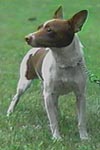
|

|
We will demonstrate how these two formulas
will combine to produce the following colors. Starting with:
The (A Series)
Female Male
A at
at at The females A
gene combines with the males at gene = Pup #1
Aat
This produces a Black puppy because the
dominant A gene doesn't allow the tan in the (at) gene to
be seen.
A at
at at The females at
gene combines with the males at gene = Pup
#2 atat
This produces a Black and Tan puppy
A at
at at The males at
gene combines with the females A gene
= Pup #3 atA
This produces the same color as pup
#1 (Black)
A at
at at The males at gene
combines with the females at gene =
Pup
#4 atat
This produces the same color as pup
#2 (Black and Tan)
At this point we have
2
black puppies and 2 black and tan puppies without the addition
of the other genes. The affects of the following genes will serve to add
to or modify the affects of the (A Series) genes.
Female Male
b b
B b The females b
gene combines with the males b gene = Pup
#1 bb
This combination produces a chocolate
dog with a brown nose
b b
B b The females b
gene combines with the males b gene = Pup
#2 bB
Because the B is dominate over
the b this combination produces a dog with a black nose.
b b
B b The males B
gene combines with the females b gene
= Pup #3 bb
This makes the same color as in
pup #1
b b
B b The males b gene combines
with the females b gene = Pup #4 Bb
This combination makes the same color
as in pup #2
When these B genes combine with the A Series combinations above, (Aat) and (atat) they can change the appearance of the dog. The (Bb) gene gives the puppies that inherit it black noses but the (bb) gene turns the black areas of the puppies that inherit it chocolate, including the "nose". The black dog will become chocolate with the (bb) gene and the black and tan dog will become chocolate and tan with the (bb) gene. Because the diagram above only shows the inheritance of genes of four pups, only two Pups, # 1 and 3 will inherit the gene that turns them chocolate.
With the A
and B genes combined we now have a black puppy, a chocolate puppy,
and a black and tan puppy.
The D Series
(DD) controls the density of the
color on the dog and will not change the color of any of the dogs we have
produced in the sample. We do not need to combine the genes because both
dogs are carrying the same and all puppies will carry (DD).
The E Series
The (EE) gene will also not change
the colors of the dogs because it is another gene that allows the pigment
to form to its fullest extent. Again, we do not need to combine the genes
because both dogs are carrying the same gene and all puppies will be (EE)
in formula.
The S Series
The S genes produce varying degrees
of white patterns on the dogs coat. Because the dogs in the example
both carry the same gene we do not need to combine them. All puppies will
carry (spsp). This gene produces the"piebald" pattern that appears
as spots or patches of color. The effects that the (sp) gene can
have on the pups is to leave them mostly white with a few spots or produce
a blanket of color on their body.
Female Male
T t
t t The females Tgene
combines with the males t gene = Pup #1
Tt
Because the T is dominate over
the t this combination produces a dog with ticking or commonly called
"freckles". It does not change the color of the dog but produces small
spots of color on the skin or coat seen only in the white areas. These
spots are the same base color of the dog and are not commonly seen at birth
but surface as the dog grows up.
T t
t t The females t
gene
combines with the males t gene = Pup #2
tt
This combination produces a dog without
ticking.
T t
t t The males t gene
combines with the females T gene =
Pup
#3 tT
This combination produces the same color
and pattern dog as pup #1.
T t
t t The males t gene
combines with the females t gene =
Pup
#4 tt
This combination produces the same color
and pattern dog as pup #2.
These combinations
were done for example purposes only. If this had been an actual mating,
the chocolate color or the ticking could have occurred on the Tri puppies
or the chocolate and white could have been black and white. Regardless,
these are the actual colors that would be produced in this type of mating.

|

|
| Back to Index NRTA |